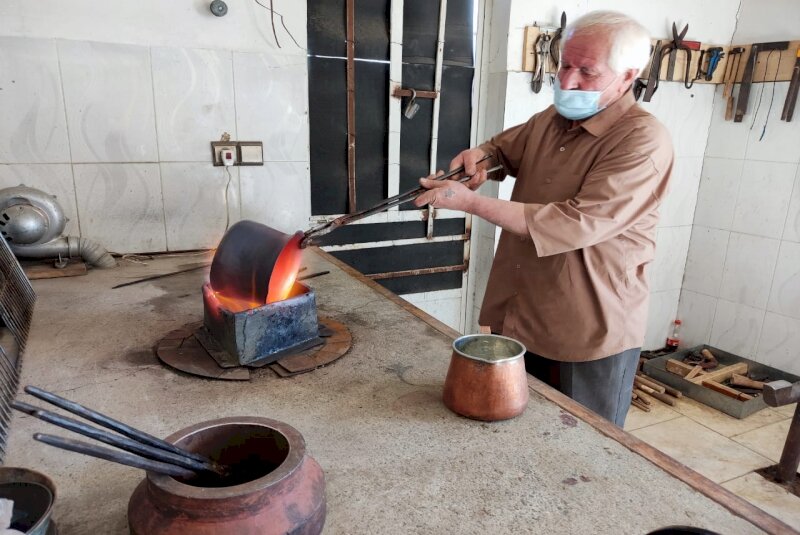Traditional craft of coppersmithing to be revived in Hamedan

TEHRAN – Traditional handicraft field of coppersmithing, which had been almost fallen into oblivion, is planned to be revived in the west-central Hamedan province, the deputy provincial tourism chief has announced.
With support for local workshops and training new crafters in this field, the forgotten handicraft field will be brought back to life, Hashem Mazaheri said on Monday.
Copper was originally used to make decorative pins, beads, headbands, mirrors, and defensive tools like swords, daggers, and knives, all of which have been discovered at the ancient Hegmataneh Hill in Hamedan, the official added.
Known in classical times as Ecbatana, Hamedan was one of the ancient world’s greatest cities. Pitifully little remains from antiquity, but significant parts of the city center are given over to excavations. Ecbatana was the capital of Media and subsequently a summer residence of the Achaemenian kings who ruled Persia from 553 to 330 BC.
Hamadan has had many names: it was possibly the Bit Daiukki of the Assyrians, Hangmatana, or Agbatana, to the Medes, and Ecbatana to the Greeks. One of the Median capitals, under Cyrus II (the Great; died 529 BC) and later Achaemenian rulers, it was the site of a royal summer palace.
About 1220 Hamedan was destroyed by the Mongols. In 1386 it was sacked by Timur (Tamerlane), a Turkic conqueror, and the inhabitants were massacred. It was partly restored in the 17th century and subsequently changed hands often between Iranian ruling houses and the Ottomans.
Sitting on a high plain, Hamedan is graciously cool in August but snow prone and freezing from December to March. In summer the air is often hazy.
Ali Sadr cave, Ganjnameh inscriptions, Avicenna Mausoleum, Hegmataneh hill, Alaviyan dome, Jameh mosque, and St. Stephanos Gregorian Church are amongst Hamedan’s attractions to name a few.
Glimpse of coppersmithing in Iran
Coppersmithing is one of the ancient handicrafts in Iran, which was practiced between the 6th and 7th millennium BC, however, the culmination of the art dates back to the Safavid era (1501-1736), when using copper dishes and objects has been popular among people.
The archeological evidence discovered at Tepe Sialk and other mining localities such as Talmesi and Anarak, and Tall-e Eblis indicates that several of the earliest sites of copper extraction were located in Iran.
During the 5th and 4th millennia BC in Iran, craftsmen were able to create enough heat to reach temperatures required for the melting of most of the then known raw materials, and thus extract metals.
On top of that copper-smelting techniques became well known in various parts of Iran in this period. With the advancement of the knowledge of metallurgy in the Achaemenid era, finely crafted copper and bronze objects were created, continuing through ancient times.
Although copper is mentioned in geographical texts much less often than precious metals, it appears to have been mined over wide areas of Persia in early Islamic times.
Objects apparently made of unalloyed copper survive in very small quantities from early Islamic times. The general rarity of early Islamic copper objects is probably because they were normally purely utilitarian, beaten out of sheet copper, and left undecorated for town or village use; they would have been melted down and reworked when old.
In the 15th century, however, decorated objects made of tinned copper became common. The reasons for this change are unclear but may have been related to the gradual dwindling of interest in inlaid base metals and the return to precious metals for luxury objects.
Under the Safavids, tinned copper seems to have been common throughout Persia, whence the taste spread to Mughal India. The designs on most Safavid tinned-copper objects seem to have been derived from the Timurid tradition, rather than that of the Turkman dynasties, though some are related in style to Safavid painting. For example, a group of objects with figural decoration has been linked to western Persia in the second quarter of the 17th century.
Wide-ranging handicrafts
With 14 entries, Iran ranks first globally for the number of cities and villages registered by the World Crafts Council, as China with seven entries, Chile with four, and India with three ones come next.
The Islamic Republic exported $427 million worth of handicrafts during the first eleven months of the calendar year 1398. Of the figure, some $190 million was earned via suitcase trade (allowed for customs-free and tax-free transfer) through 20 provinces, according to data compiled by the Ministry of Cultural Heritage, Tourism and Handicrafts.
Ceramics, pottery vessels, handwoven cloths as well as personal ornamentations with precious and semi-precious gemstones are traditionally exported to Iraq, Afghanistan, Germany, the U.S., the UK, and other countries.
ABU/MG

Leave a Comment